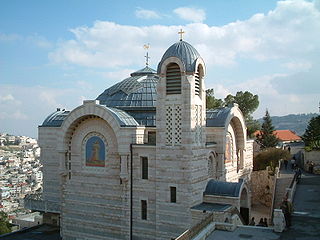Church of Saint Peter in Gallicantu
Church of Saint Peter in Gallicantu is a Roman Catholic church located on the eastern slope of Mount Zion, just outside the Old (walled) City of Jerusalem.
History
The church of Saint Peter in Gallicantu takes its name from the Latin word “Gallicantu”, meaning cock’s-crow. This is in commemoration of Peter’s triple rejection of Jesus “… before the cock crows twice.” (Mark 14:30)
A Byzantine shrine dedicated to Peter’s repentance was erected on this spot in 457 AD, but was destroyed by the Fatimid caliph Al-Hakim bi-Amr Allah in 1010. The chapel was rebuilt by Crusaders in 1102 and given its present name. After the fall of Jerusalem the church again fell into ruin and was not rebuilt until 1931. Today a golden rooster protrudes prominently from the sanctuary roof in honor of its biblical connection. This spot is also believed to be the location of the High Priest Caiaphas’ palace. According to the Pilgrim of Bordeaux in his Itinerarium Burdigalense, “…going up from the Pool of Siloe to Mount Zion one would come across the House of the Priest Caiaphas.”
Layout and Design
The entrance to the church is from a parking lot located above the main level of the church. In the courtyard is a statue that depicts the events of the denial and include its main figures; the cock, the woman, and the Roman soldier. The inscription includes the biblical passage; But he denied him, saying “Woman, I know him not”! (Luke 22:57) The entrance itself is flanked by wrought iron doors covered with biblical bas reliefs. To the right are two Byzantine-era mosaics found during excavation, these were most likely part of the floor of the fifth-century shrine. The main sanctuary contains large, multi-colored mosaics portraying figures from the New Testament. Facing the entrance is a bound Jesus being questioned at Caiaphas’ palace; on the right Jesus and the disciples are shown dining at the Last Supper; and on the left Peter, considered the first Pope, is pictured in ancient papal dress. Perhaps the most striking feature of the interior is the ceiling, which is dominated by a huge cross-shaped window designed in a variety of colors. The fourteen Stations of the Cross also line the walls and are marked with simple crosses.
Beneath the upper church is a chapel which incorporates stone from ancient grottos inside its walls. Down a hole in the center of the sanctuary one can see caves that may have been part of the Byzantine shrine. These walls are engraved with crosses left by fifth-century Christians. On an even lower level there is a succession of caves from the Second Temple period. Since tradition places the palace of Caiaphas on this site, many believe that Jesus may have been imprisoned in one of these underground crypts after his arrest, however, these underground caves were normal in many Roman-era homes, and often served as cellars, water cisterns, and baths. On the north side of the church is an ancient staircase that leads down towards the Kidron Valley. This may have been a passage from the upper city to the lower city during the first temple period. Many Christians believe that Jesus followed this path down to Gethsemane the night of his arrest.
Source : wikipedia
https://www.youtube.com/watch?v=og8GnG6voG8
https://www.youtube.com/watch?v=77imhCg2pWs
Reviews
https://goo.gl/K2z2IA



Rate this article